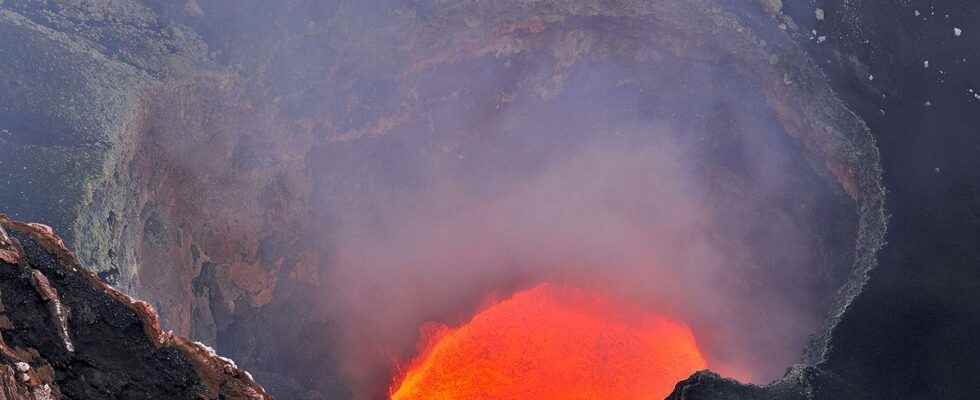In the archipelago of Vanuatu, located off the Pacific Ocean, an eruption began on January 25 in the Bembow crater, at the top of the volcano on Ambrym Island. Eruptive activity is confined to it and could mark the return of a lava lake to this location, as between 2008 and 2018.
You will also be interested
[EN VIDÉO] Interview: the different types of volcanoes, with Jacques-Marie Bardintzeff Volcanoes play a very important role for the planet and have done so for billions of years. While some are considered sacred, others have extraordinary characteristics… © Futura
It was at the end of the night on January 25 that the scientists of the Vanuatu Meteorology & Geo-Hazards Department noticed the increase in the internal activity of the volcano, quickly followed by a voluminous plume of vapors emanating from the Bembow crater, at the top of the volcano. The alert level was thus increased from 1 to 2 and, during the day, the satellite images revealed a anomaly persistent thermal at this level, as well as emissions dioxide sulfur and an incandescent in the evening.
These manifestations attest to the return of the lava inside this crater. The few remarkable ashes in the degassing plume testify to a very modest explosive activity, undoubtedly associated with an effusive activity. We are impatiently awaiting the first images of this activity, but it could be that a lava lake return to this place, which had not been noticed since December 2018. A kind of return to normal.
Back to normal
In fact, the activity eruptive of this volcano is almost permed, in either of the two summit craters, Bembow and Marum. For twenty-five years, the volcano was thus in eruption between 1996 and 2005, then between 2006 and 2007 and, finally, between 2008 and 2018! But, in December 2018, an eruption in the caldera summit led to the emptying the lava lakes of Bembow and Marum, at the origin of important collapses inside the craters. We were waiting to know when the lava would come back… It’s done!
Drone views of caldera and lava lake landscapes in Marum Crater. © Silver Eye Films
The eruption being of a modest scale and located inside one of the summit craters, the risks for population are minor. This being so, the acid rain and the fumes of gas could hamper the lives of the several thousand inhabitants of this island.
Other views of the Marum lava lake. © Ced Northman
The bubbling lava lake of the Marum Volcano The lava lake of the Marum volcano, in Vanuatu, works very differently from that of Nyiragongo. It is constantly agitated with intense bubbling. © Olivier Grunewald
The Marum lava lake in Vanuatu On this island of the volcanic archipelago of Vanuatu, the island of Ambrym offers the spectacle of two lava lakes. That of Marum, at the bottom of a vertiginous crater, and that of Bembow, more difficult to see. © Olivier Grunewald
The Erta Alé lava lake in Ethiopia In the north of Ethiopia, the Erta Alé volcano has undergone enormous variations in activity over the past 18 years. In 2001, it was about 80 meters in diameter. © Olivier Grunewald
The Erta Alé lava lake sometimes overflows The Erta Alé lava lake continued to rise until it outcropped and then collapsed in January 2017 producing an ash plume nearly 700 meters high. Immense lava flows have been pouring out for more than a year. © Olivier Grunewald
The Erta Alé lava lake: the pit of hell In 2002, a scientific mission went down to take measurements and take samples from the bottom of the 80-meter-deep well of the Erta Alé volcano in this isolated area in northern Ethiopia. © Olivier Grunewald
The Nyiragongo lava lake, a scientific laboratory It is the regular monitoring and the collection of data that will one day allow a better understanding of these mysterious lava lakes. © Olivier Grunewald
The Nyiragongo lava lake is not so easy to access Lowering all the equipment to the heart of the Nyiragongo volcano requires significant logistics and very good physical preparation. © Olivier Grunewald
Bubbles burst the surface of the Nyiragongo lava lake The surface of the Nyiragongo lava lake is fracturing and huge gas bubbles are bursting its surface. © Olivier Grunewald
The Nyiragongo lava lake seen up close Photographed from a meter away, this ocean of magma reveals its partially cooled crust. © Olivier Grunewald
The Nyiragongo lava lake at the bottom of its crater The scientific missions that go down to work in the heart of Nyiragongo settle on a camp site as close as possible to the show. © Olivier Grunewald
The lava lake of Nyiragongo under the eye of a webcam In 2011, the team of the Society of Volcanology of Geneva worked on the installation of a webcam to be able to monitor the lava lake permanently. © Olivier Grunewald
The Nyiragongo lava lake in its multiple crater At the bottom of its immense crater, the largest lava lake, that of Nyiragongo, is constantly active. © Olivier Grunewald
Interested in what you just read?
